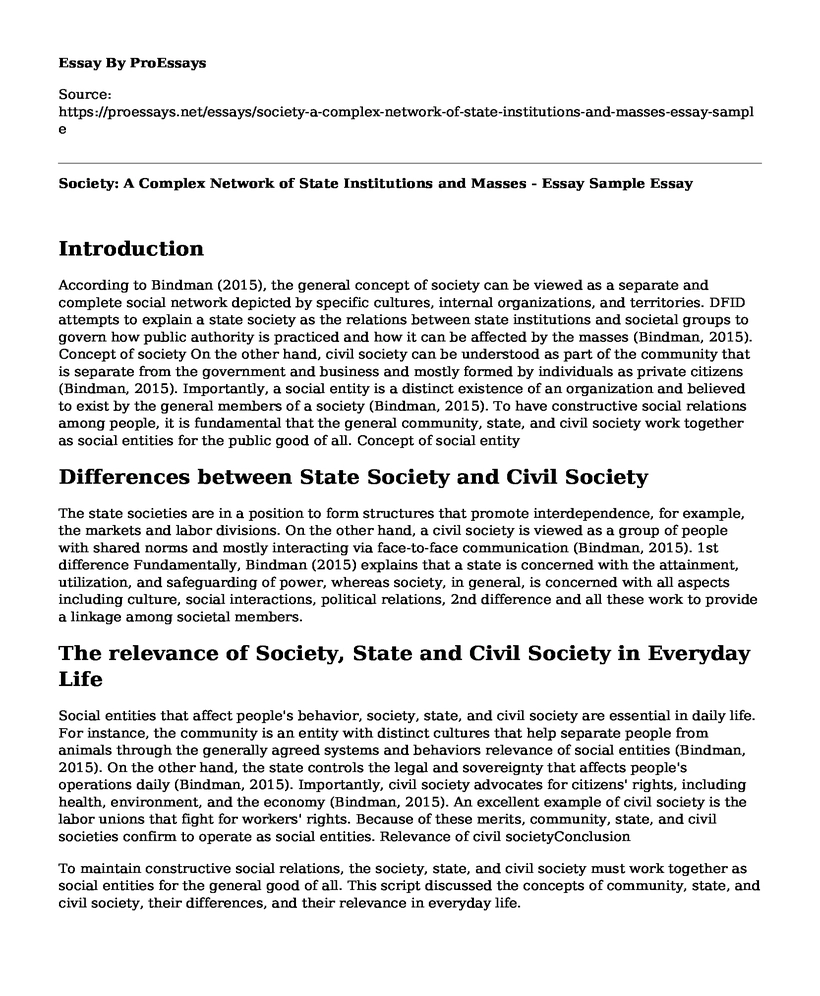Introduction
According to Bindman (2015), the general concept of society can be viewed as a separate and complete social network depicted by specific cultures, internal organizations, and territories. DFID attempts to explain a state society as the relations between state institutions and societal groups to govern how public authority is practiced and how it can be affected by the masses (Bindman, 2015). Concept of society On the other hand, civil society can be understood as part of the community that is separate from the government and business and mostly formed by individuals as private citizens (Bindman, 2015). Importantly, a social entity is a distinct existence of an organization and believed to exist by the general members of a society (Bindman, 2015). To have constructive social relations among people, it is fundamental that the general community, state, and civil society work together as social entities for the public good of all. Concept of social entity
Differences between State Society and Civil Society
The state societies are in a position to form structures that promote interdependence, for example, the markets and labor divisions. On the other hand, a civil society is viewed as a group of people with shared norms and mostly interacting via face-to-face communication (Bindman, 2015). 1st difference Fundamentally, Bindman (2015) explains that a state is concerned with the attainment, utilization, and safeguarding of power, whereas society, in general, is concerned with all aspects including culture, social interactions, political relations, 2nd difference and all these work to provide a linkage among societal members.
The relevance of Society, State and Civil Society in Everyday Life
Social entities that affect people's behavior, society, state, and civil society are essential in daily life. For instance, the community is an entity with distinct cultures that help separate people from animals through the generally agreed systems and behaviors relevance of social entities (Bindman, 2015). On the other hand, the state controls the legal and sovereignty that affects people's operations daily (Bindman, 2015). Importantly, civil society advocates for citizens' rights, including health, environment, and the economy (Bindman, 2015). An excellent example of civil society is the labor unions that fight for workers' rights. Because of these merits, community, state, and civil societies confirm to operate as social entities. Relevance of civil societyConclusion
To maintain constructive social relations, the society, state, and civil society must work together as social entities for the general good of all. This script discussed the concepts of community, state, and civil society, their differences, and their relevance in everyday life.
References
Bindman, E. (2015). The state, civil society, and social rights in contemporary Russia. East European Politics, 31(3), 342-360.
Cite this page
Society: A Complex Network of State Institutions and Masses - Essay Sample. (2023, Aug 25). Retrieved from https://proessays.net/essays/society-a-complex-network-of-state-institutions-and-masses-essay-sample
If you are the original author of this essay and no longer wish to have it published on the ProEssays website, please click below to request its removal:
- The Contribution of the Album Illmatic in Reinforcing Racist Ideologies
- Using Feminist Ideas to Raise Boys Who Are Not Misogynists Essay
- The Negative Effect of Divorce Parents on Child Physics - Essay Sample
- Family Closeness in Decline: Causes & Effects - Essay Sample
- Open Borders: Re-Imagining Global Politics Beyond Country Limits - Essay Sample
- Paper Example on Black Lives Matter: 150 Yrs of Struggle for Justice
- Biography Sample on Jane Addams: Champion of Peace, Philanthropy, Work Ethic







